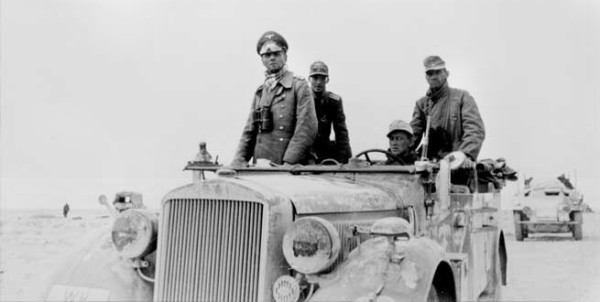
Nazi General Erwin Rommel launched an offensive in Libya in 1941. He is seen here in 1943. commons.wikimedia.org
By: Phil Kohn. Dedicated to the memory of his father, GM3 Walter Kohn, U.S. Navy Armed Guard, USNR, and all men and women who have answered the country’s call in time of need. Phil can be contacted at ww2remembered@yahoo.com.
In East Africa, troops of the British 11th (African) Division attack strong Italian positions in the Marda Pass, west of Jijiga, in eastern Ethiopia, on March 21, 1941. After some resistance, the Italians pull out and fall back. In Philadelphia, Joe Louis again successfully defends his heavyweight boxing title, defeating Abe Simon by a technical knockout in the 13th round.
On March 22 the German battleships Scharnhorst and Gneisenau enter the shelter of French waters. The two vessels have wreaked considerable havoc on the British convoy system, sinking 22 ships totaling 115.600 registered tons. In East Africa, British forces overrun another Italian defensive position west of Jijiga, Ethiopia, at Babile Pass.
Accompanied by fighters, German Stuka dive-bombers on March 23 raid Malta. As a result of the attack, the British withdraw all RAF bombers and flying boats from the island.
On March 24 German Lt. Gen. Erwin Rommel launches his first offensive in Cyrenaica (Libya), recapturing El Agheila from the British. With significant numbers of veteran British desert troops sent to Greece, Lt. Gen. Phillip Neame is left to hold Libya with the under-strength 2nd Armoured Division, the 9th Australian Division and an Indian brigade. In addition, their tanks are mostly old and worn-out. (Neame has replaced Lt. Gen. Richard O’Connor, who has been made commander of British Troops in Egypt.) Rommel, on the other hand, has one German division — the 5th Light Division, with a strong tank component — and parts of four Italian divisions under his command. But Rommel, too, has his problems: the German High Command has forbidden him from attacking and has notified him he will receive no extra forces until May.
In Vienna, Austria, on March 25, Yugoslavia’s Prime Minister Dragiša Cvetković and Foreign Minister Dimitrije Cincar-Marković, yielding to German pressure, sign the Tripartite Pact, joining the Axis. Germany agrees to respect Yugoslavian sovereignty and not demand passage for its troops. In Belgrade, civil disturbances break out when it becomes known that the country has joined the Axis. In Eritrea, in the Horn of Africa, the 4th and 5th Indian Divisions renew their advance toward an Italian blocking position along the Keren road.
Following claims by the Luftwaffe that it has sunk two battleships of the British Mediterranean Fleet (not true), and with the promise of air cover and reconnaissance, Adm. Angelo Iachino on March 26 leads the Italian fleet into the Aegean Sea with the intent of disrupting British convoys to Greece. His force comprises one battleship, six heavy cruisers, two light cruisers and 13 destroyers. The same day, British forces occupy Harar, Ethiopia. During the night, an attack by a special Italian naval unit’s explosive motorboats penetrates Suda Bay, Crete, in the Greek islands, sinking one tanker and crippling the British heavy cruiser HMS York.
On March 27, the British Royal Navy moves out to engage the Italian fleet. Adm. Andrew Cunningham leads three battleships, one aircraft carrier and nine destroyers out of Alexandria, Egypt, while Vice Adm. Henry Pridham-Wippell sorties four light cruisers and four destroyers from Piraeus, Greece. In Yugoslavia, an anti-Axis coup d’etat by air force officers deposes Prince Paul and forces him into exile. King Peter II, a minor (he’s only 17), assumes the throne, with Royal Yugoslav Air Force Chief of Staff Dušan Simović as the head of government. In response, a furious Adolf Hitler issues “Führer Directive No. 25” that orders an immediate invasion, with the objective “to destroy Yugoslavia militarily and as a state.” In East Africa, Platt’s Allied advance clears roadblocks in the Keren area of Eritrea, with the Italians falling back toward Asmara. The fighting is brutal, with the Indian divisions suffering 4,000 casualties and the Italians losing 3,000 dead and many wounded.







